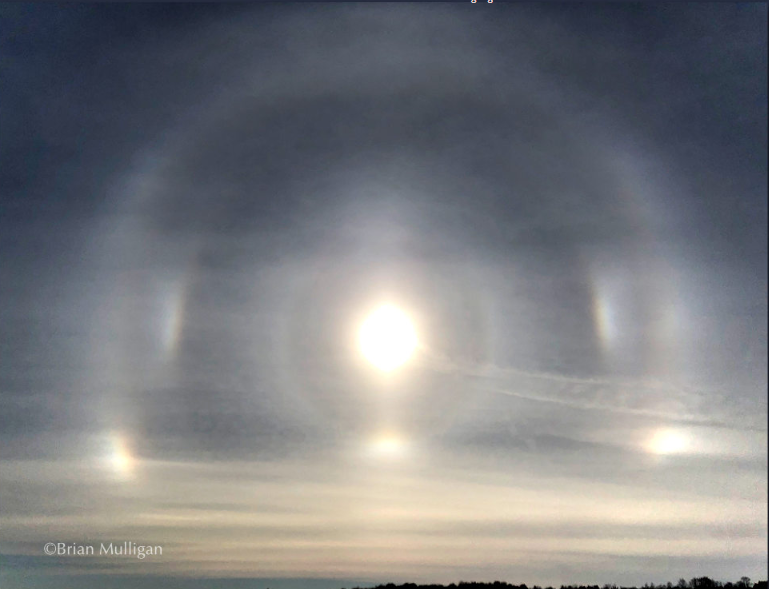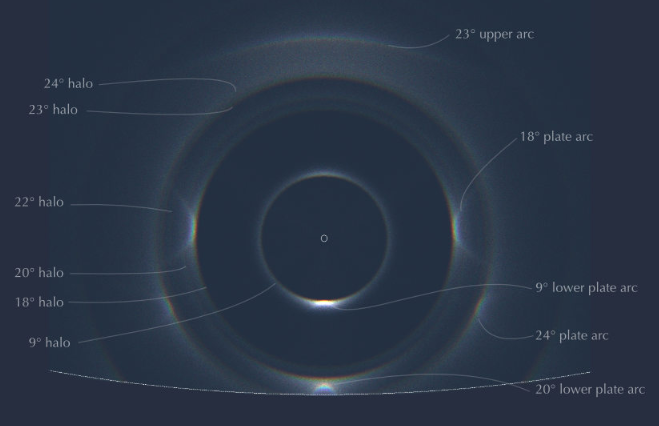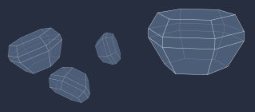Pyramidal crystal plate arc halo display, Ottawa
Pyramidal Crystal Plate Arc Halo Display in Ottawa
On October 21, 2019, Ottawa, Ontario, Canada was treated to a mesmerizing halo display that left onlookers in awe. The display, captured by Brian Mulligan, showcased several colored spots and faint rings surrounding the low afternoon sun. What made this display particularly unique was the presence of pyramidal ice crystals, as opposed to the more common hexagonal prisms, which created a stunning visual spectacle.
Pyramidal ice crystals differ from hexagonal prisms in their shape and aerodynamic properties. These crystals have a more rounded shape and tend to tumble as they fall through the atmosphere. As a result of their random orientations, they give rise to circular "odd-radius" halos. However, in the case of the Ottawa display, some of the pyramidal crystals were flattened and took on a 'plate' orientation, which gave rise to the rare phenomenon known as 'plate arcs.'
To understand this phenomenon better, researchers have conducted simulations using a crystal model known as HaloSim. The model used a specific type of crystal with a narrow central belt of ordinary hexagonal prism side faces topped by a truncated pyramid with a deeper pyramid below. These crystals were chosen based on simulations conducted by Martin Viala, who also observed the halos. While the fit between the model and the actual display is reasonable, it is not perfect. The model assumes symmetrical perfect crystals, which are rarely found in clouds. Therefore, adding more crystals of different habits and adjusting various parameters may not necessarily improve the accuracy of the model.
One intriguing aspect of the Ottawa display was the absence of familiar sundogs, which are usually observed alongside halo displays. In this case, sundogs were weak or entirely absent both in reality and in the simulation. The reason behind this lies in the crystal structure. Sundog rays typically do not pass directly through plate crystals, but instead, they internally reflect up and down from the upper and lower large hexagonal faces. However, in the pyramidal crystals observed in Ottawa, these faces were too small and too far apart for this internal reflection to occur. Additionally, the wobbling motion of the large crystals further contributed to the absence of sundogs.
In conclusion, the pyramidal crystal plate arc halo display witnessed in Ottawa was a truly remarkable atmospheric optics event. The presence of pyramidal ice crystals, their flattened plate orientation, and the absence of sundogs added an element of rarity to the display. While simulations have been conducted to understand the phenomenon better, the complexities of crystal habits and parameters make it challenging to accurately model such events. Nonetheless, events like these remind us of the wonders that occur in our atmosphere and the endless possibilities for optical phenomena.

Pyramidal Crystal Halos
Ottawa, Ontario, Canada saw this spectacular halo display on October 21, 2019. Brian Mulligan imaged it.
Several coloured spots and fainter rings surround the low afternoon sun.
Pyramidal ice crystals rather than the more usual hexagonal prisms created the display. Pyramidal crystals are aerodynamically more rounded and they tumble. Their orientations are thus random and they create circular "odd-radius" halos.
Not in Ottawa! Some of the crystals were fairly flattened and took a 'plate' orientation. These created the rare 'plate arcs' - the spots and curves.

An attempt at ray tracing the display using HaloSim.
Only one type of crystal was used. It had a narrow central belt of ordinary hexagonal prism side faces topped by a truncated pyramid with a deeper pyramid below. The choice is based on simulations made by Martin Viala who also saw the halos.
Some crystals were plate oriented but very wobbly (12° std dev dispersion) and the remainder randomly oriented to generate the circular halos.
The fit is reasonable but not good. The model has symmetrical perfect crystals that rarely occur in clouds. It's tempting to add more crystals of different habit and twiddle the many parameters but that is of arguable value.

Where are the familiar sundogs? They were weak in Ottawa and absent from the simulation. There is a central ring of prism side faces that ought to allow 22° parhelia rays?
Except near sunrise and sunset, sundog rays to not go directly through plate crystals. Instead they internally reflect up and down from the upper and lower large hexagonal faces.
Alas, the latter are too small and too far separated for that to occur in these pyramidal
crystals. Another factor is the large crystal wobbles.
Note: this article has been automatically converted from the old site and may not appear as intended. You can find the original article here.
Reference Atmospheric Optics
If you use any of the definitions, information, or data presented on Atmospheric Optics, please copy the link or reference below to properly credit us as the reference source. Thank you!
-
<a href="https://atoptics.co.uk/blog/pyramidal-crystal-plate-arc-halo-display-ottawa/">Pyramidal crystal plate arc halo display, Ottawa </a>
-
"Pyramidal crystal plate arc halo display, Ottawa ". Atmospheric Optics. Accessed on November 26, 2024. https://atoptics.co.uk/blog/pyramidal-crystal-plate-arc-halo-display-ottawa/.
-
"Pyramidal crystal plate arc halo display, Ottawa ". Atmospheric Optics, https://atoptics.co.uk/blog/pyramidal-crystal-plate-arc-halo-display-ottawa/. Accessed 26 November, 2024
-
Pyramidal crystal plate arc halo display, Ottawa . Atmospheric Optics. Retrieved from https://atoptics.co.uk/blog/pyramidal-crystal-plate-arc-halo-display-ottawa/.